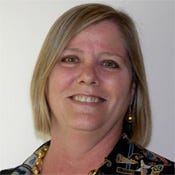National Lab Replaces Supercomputer With Newer, Faster Model
Argonne National Laboratory's new 'Mira' takes on climate studies and other major scientific challenges at 8 petaflops, third fastest computer performance in the world.


Slideshow: Government's 10 Most Powerful Supercomputers
Slideshow: Government's 10 Most Powerful Supercomputers(click for larger image and for full slideshow)
Argonne National Laboratory is taking applications from scientists that want to use its new Mira supercomputer, recently ranked the third fastest in the world, to solve large, complex problems.
With 768,000 core processors Mira operates at more than 8 petaflops, putting it near the top of the list of the world's most powerful computers. Its initial applications include studying the quantum mechanics of new materials, measuring the role and impact of clouds on climate, and modeling earthquakes.
These and 13 other projects under development as part of Argonne's Early Science Program are intended to advance science, as well as evaluate Mira's performance, said Mike Papka, deputy associate director of Argonne's Computing, Environment and Life Sciences directorate. Papka also directs the Argonne Leadership Computing Facility, one of two such facilities--the other is at Oak Ridge National Laboratory--supported by the Department of Energy. The leadership computing facilities were created under the America COMPETES Act, signed into law under President George W. Bush in 2007 and reauthorized by Congress and re-signed by President Obama. COMPETES stands for Creating Opportunities to Meaningfully Promote Excellence in Technology, Education, and Science.
[ Read IBM Yellowstone Supercomputer To Study Climate Change. ]
Mira is due to become fully operational next year. Under the Early Science Program, software is being developed and optimized for use on Mira, an IBM Blue Gene/Q system. "A new architecture with a new system software stack, and at a scale that is larger than anyone else has run previously, results in a system that will have issues never seen before," Papka said. "These issues need to be exposed and addressed before we go into production, and it often requires real users running real code on the system."
Mira replaces an older Blue Gene/P supercomputer, Intrepid, at Argonne. Just four years ago, Intrepid was rated the fastest supercomputer in the world at 557 teraflops. Now it looks as though the system will be decommissioned.
Sixty percent of Mira's processing cycles will be devoted to projects selected for DOE's Innovative and Novel Computational Impact on Theory and Experiment (INCITE) program, which is open to researchers in government, academia, and industry. Scientific proposals are evaluated for their quality, relevance, and computational readiness by an independent panel of experts, much like a financial review or journal submission. The first round of INCITE applications were submitted in June, with time allocations to be assigned in January 2013.
Another chunk of Mira's processing time, 30%, will go to projects accepted into the Advanced Science Computing Research Leadership Computing Challenge. These are focused on topics directly relevant to DOE's energy priorities. Proposals are due at the beginning of 2013, with time allocations made next June.
The remaining 10% of Mira's time will be used for projects that are determined to have an "immediate need," Papka said. For example, during the Deepwater Horizon oil spill in the Gulf of Mexico in 2010, scientists used Intrepid to run simulations of oil rising through the water.
For the time being, Argonne is allocating time on both Mira and Intrepid until the former becomes fully operational and the latter is taken out of service. Given the costs of maintenance, power, and support, it's not feasible to operate both of them. Intrepid could potentially be sold to a university or other organization, but more likely is that it will be scavenged for re-usable parts, such as compute nodes, boards, cards, racks, and power modules.
InformationWeek is conducting a survey to determine how IT is perceived in the enterprise. Take our InformationWeek 2012 IT Perception Survey now. Survey ends Aug. 3.
About the Author
You May Also Like






